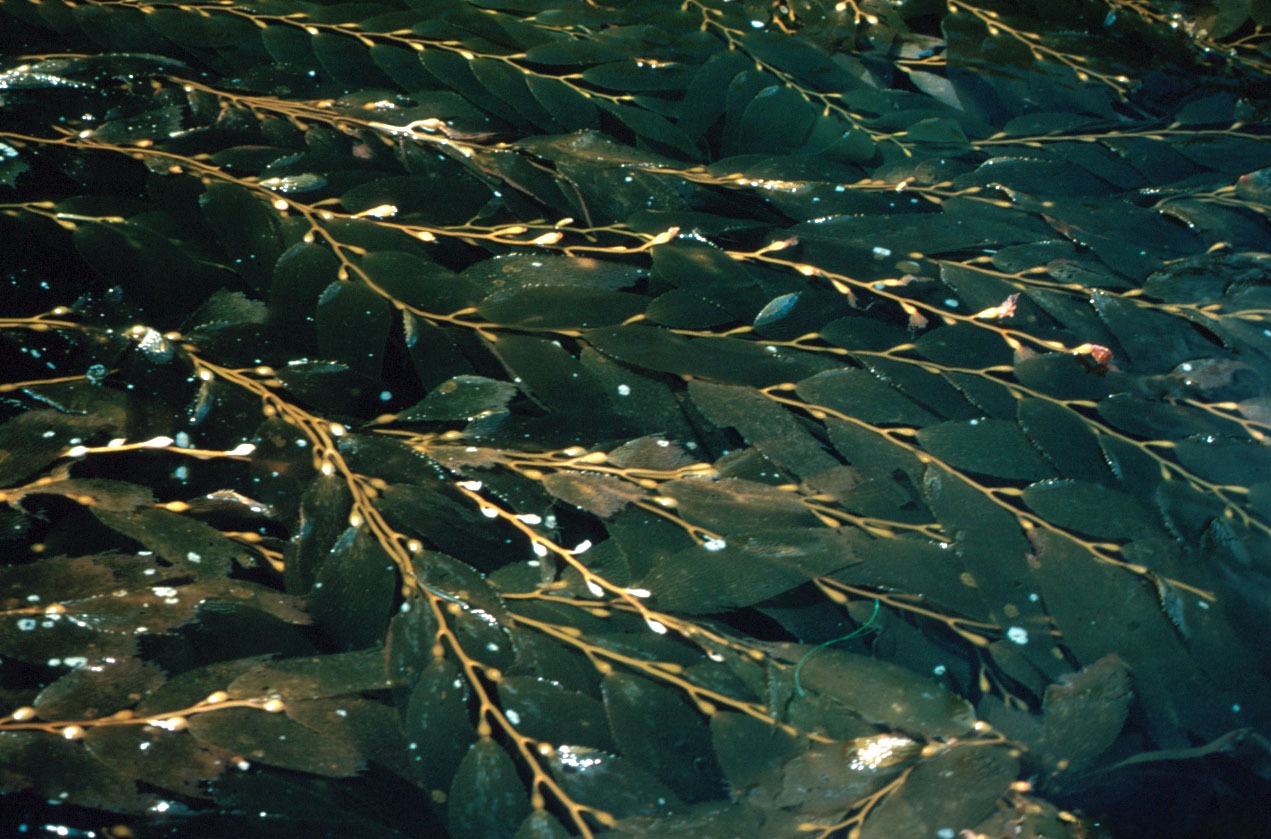- Macrocystis
Taxobox
name = "Macrocystis"

image_width = 200px
image_caption = "Macrocystis pyrifera "
domain =Eukaryota
regnum =Chromalveolata
phylum =Heterokont ophyta
classis = Phaeophyceae
ordo =Laminariales
familia =Lessoniaceae
genus = "Macrocystis"
subdivision_ranks = Species
subdivision = "Macrocystis angustifolia "
"Macrocystis integrifolia "
"Macrocystis laevis "
"Macrocystis pyrifera ""Macrocystis" is a genus of
kelp (algae ). This genus contains the largest of all thephaeophyceae orbrown algae . "Macrocystis" haspneumatocyst s at the base of itsblade s.Sporophyte s are perennial, and individual stipes may persist for many years. Common along the coast of the easternPacific Ocean , from centralCalifornia toBaja California and north to southeast Alaska (Sitka).One species, "macrocystis pyrifera", under this genus, has the fastest linear growth of any organism on earth. [Fenner, Bob [http://www.wetwebmedia.com/brnalgae.htm "The Brown Algae"] ] They can grow two hundred feet long at a rate of two feet a day.
Description
"Macrocystis" is a genus of kelp, some species of which are so huge that the plants may grow to up to 60m (200ft).Hoek at al] The stipes arise from a
holdfast and branch three or four times from near the base. Blades develop at irregular intervals along the stipe.Mondragon and Mondragon] Abbott and Hollenberg] "M. pyrifera" grows to over 45m (150ft) long. [Cribb]The stipes are unbranched and each blade has a gas bladder at its base.Kain]
Life cycle
The
sporophyte has many sporangia located in its blades, which, throughmeiosis , releaseshaploid spores , which will grow into female and malegametophytes . These gametophytes growmitotically , and produce gametes, sperm and eggs. The gametophytes are microscopic. The female has larger and fewer cells then the male. The male releases its sperm, which find their way to the female, following a pheremone released by the female, there it fertilizes the egg, to form thezygote , which, through mitosis, begins growth.Growth
Juvenile giant kelp grow directly on the parent female gametophyte, extending one or two primary blades, and beginning a rudimentary holdfast, which will eventually cover the gametophyte completely. Growth occurs with lengthening of the stipe, and splitting of the blades. This occurs by means of small tears where the blade meets the stipe, which splits the stipe into two. Pneumatocysts grow after the first few blade splittings.
Ecology
Grows forming extensive beds, large "floating canopies", on a rocky substrate.
pecies
There are four species of "macrocystis". [
AlgaeBase : [http://www.algaebase.org/search/genus/detail/?genus_id=35715 Genus: Macrocystis] ]* "Macrocystis angustifolia" Bory de Saint-Vincent
* "Macrocystis integrifolia" Bory de Saint-Vincent
* "Macrocystis laevis" C.H.Hay;
* "Macrocystis pyrifera" (L.) C.Ag; and "M. pyrifera" var. "humboldtii" Bomplan.
Distribution
* "Macrocystis pyrifera", known as giant kelp, is found in
North America (Alaska toCalifornia ),South America ,South Africa ,New Zealand , and southernAustralia . [AlgaeBase : [http://www.algaebase.org/search/species/detail/?species_id=4427 Species: Macrocystis pyrifera] ] It can grow over 45 metres long and can do so in one growing season, making it the organism with the world's fastest linear growth.
* "Macrocystis integrifolia", a smaller, intertidal species, is found on thePacific coast of America (British Columbia toCalifornia ) and South America.* "Macrocystis integrifolia" is much smaller, the sporangial thalli growing only to 6 m long; it is found on intertidal rocks or shallow subtidal rocks. [
AlgaeBase : [http://www.algaebase.org/search/species/detail/?species_id=4882&sk=0&from=results Species: Macrocystis integrifolia] ]
Wikimedia Foundation. 2010.
